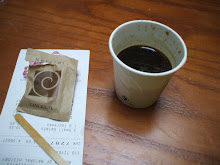After delivering our second batch of beer a little over a month ago, I realized that some of our friends who have been tasting the different beers were holding on to bottles that were almost four months old — and older now. As we delivered the latest beers, we tasted the last set and discovered that they were starting to lose their character. This is nothing unusual for unfiltered, unpasteurized beers, but the closer I get to the business, the more I learn about what makes things work — and fail. I've heard of brewers tracking down beer on shelves after it's passing its prime, and I'm close to doing that myself.
What happens to the beer? The hops begin to fade, first of all. When hops fade, any flaws in malt character become more obvious. Styles tend to lose their differentiation. Any other flaws in production — infections, unsuccessful malt bills, and more — become glaring. We're not necessarily talking about skunked beer here, just beer that isn't as good as it should be. In general, the beer just goes bad.
When I try to explain this to non-brewers, I get glazed-over looks. I guess we're trained to believe that most things are immutable and will last as long as a processed cheese single. But the truth is that craft beer can be as delicate as good bread, ice cream or vegetables. These things go bad after a while, and so will beer.
Not every beer, though. Non-beer-geeks may know that some of us cellar bottles for months or years. These are beers with yeast that will keep working and ABVs that give them a decent shelf-life. These beers may have been aged in oak casks. They may have had grape must added. They may have interesting additives like honey or herbs with flavors that will evolve over time. In short, these are beers made to age. Think about a young Sauvignon Blanc versus an oak-aged Meritage, and you'll get the idea.
Fresh craft beer isn't made to age, however. Drink it as you get it, and you'll be happier. Oh, and it's beer. Good beer, hopefully.
skip to main |
skip to sidebar

I'm back. Have a blast, y'all.

About Me
Blog Archive
- June (1)
- July (1)
- May (5)
- January (3)
- December (1)
- November (2)
- September (4)
- August (11)
- July (7)
- June (1)
- May (2)
- April (2)
- March (5)
- February (4)
- January (4)
- November (3)
- October (3)
- September (3)
- August (1)
- July (3)
- April (2)
- March (5)
- February (3)
- January (7)
- December (8)
- November (12)
- October (5)
- September (8)
- August (6)
- July (5)
- June (14)
- May (13)
- April (24)
- March (21)
- February (22)
- January (22)
- December (20)
- November (26)
- October (24)
- September (35)
- August (27)
- July (36)
- June (21)
- May (26)
- April (28)
- March (27)
- February (20)
- January (38)
- December (26)
- November (11)
- October (32)
- September (33)
- August (30)
- July (36)
- June (34)
- May (50)
- April (36)
- March (3)
- January (3)
- December (3)
- November (3)
- August (6)
- July (4)
What I Like
- A List Apart
- Accidental Creative
- AdLand
- AdRants
- Atrios
- Batocchio
- Byrd House Market
- Chowhound
- Creating Passionate Users
- daddytypes.com
- Daily Kos
- Design Observer
- design*sponge
- Epicuriousity (John Haddad)
- Flickr shots
- Gawker
- Getting Real - 37 Signals
- Gothamist
- Incertus
- Phil's bookmarks (web design and more)
- river city food and wine
- Smeltery fonts
- TreeHugger
- Veer
- Vitaly Friedman's fonts
- Wonkette
- Wornamental, Thornamental Design
- Xtcian
- zefrank
